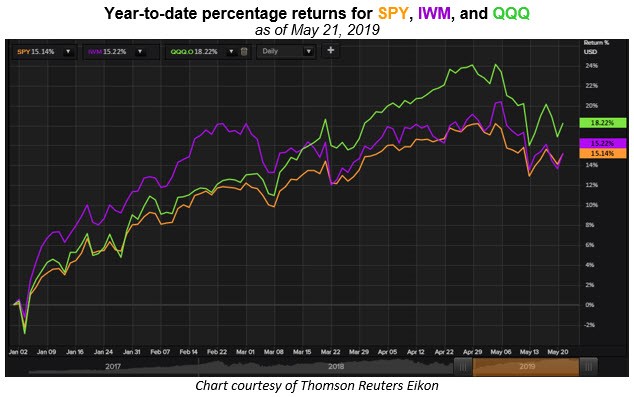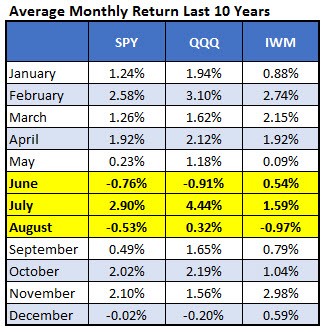The major stock indexes have seasonal tendencies that can be traded this summer, notes Elizabeth Harrow.
Among the major U.S. equity-based exchange-traded funds (ETFs), 2019 has largely been a battle for dominance between small caps and tech. In January, small caps jumped out to a big lead, as the iShares Russell 2000 ETF (IWM) began racking up outsized gains relative to the benchmark SPDR S&P 500 ETF (SPY). That small-cap dominance persisted through mid-March, when the tables turned -- and suddenly, the tech-loaded Invesco QQQ Trust (QQQ) broke away from its tight relationship with SPY to surge higher, just as IWM cooled its jets.
All three of these equity ETFs have pulled back during the month of May, but QQQ is maintaining its year-to-date lead over IWM and SPY by a few percentage points, as of this writing. However, as we draw closer to the unofficial start of summer trading, the last decade's worth of seasonal data suggests that this year's ongoing IWM vs. QQQ power struggle is far from over.

Small Caps Stand Out in June
Historical monthly returns compiled by Schaeffer's Senior Quantitative Analyst Rocky White suggest that June could be a lackluster month for the stock market, if the last 10 years are any indication. Both SPY and QQQ have averaged negative returns in June over the last decade, with only 40% positive returns during the month. In fact, both ETFs tend to record their worst average monthly returns of the calendar year during June— down 0.76% for SPY, and 0.91% for QQQ.
On the other hand, IWM manages a 0.54% gain, on average, during the month of June. The Russell 2000 tracker is positive 60% of the time during the final month of the second quarter. This seasonality quirk could give the small caps an edge over tech stocks in the immediate post-Memorial Day period.
But QQQ Bats 1,000 in July
Having said that, it's hard not to be impressed by QQQ's midsummer track record. Over the past 10 years, the ETF has ended the month of July higher 100% of the time, with a robust average return of 4.44%. That easily outshines SPY's average July return of 2.90% (80% positive), and it nearly triples IWM's mean July performance -- up 1.59%, with only 60% positive returns.

Of course, this spotless 10-year streak doesn't guarantee that QQQ will rally again in July 2019. But it does confirm that the tech sector has regularly left small caps in the dust during the month of July, which generally features a glut of high-profile earnings reports.
Within the tech space, traders may want to keep a particularly close eye on the internet group, namely, the First Trust Dow Jones Internet Index Fund (FDN). According to White's historical data, FDN is one of the top-performing sector ETFs of the last decade during the period from Memorial Day to Labor Day, with an average return of about 6% over this time frame.
IWM Takes a Turn for the Worst in August
While SPY and QQQ both tend to get their worst month of the year out of the way in June, it comes for IWM in August. The ETF averages a drop of 0.97% this month, with 50% positive returns. Likewise, SPY goes negative in August— though not quite as drastically as IWM, with a 10-year average return of 0.53% for the month, and 60% positive returns.
Conversely, QQQ tends to coast through August on its bullish July momentum. The ETF ends August higher 60% of the time, with a narrowly positive average return of 0.32% — showing up both SPY and IWM.
Tech Stocks Could Have the Edge This Summer
On balance, it looks like the deck is stacked toward a continuation of QQQ outperformance over the summer, but remember, that's purely from a seasonality perspective. While this data provides some useful historical context, it should be paired with the usual technical, fundamental, and investor sentiment analysis to provide a holistic basis for your warm weather investing decisions.





















